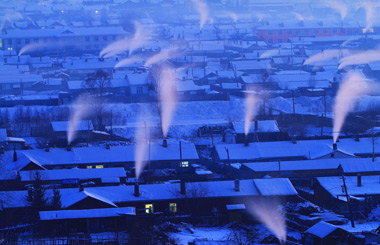Flight of the bumblebee
In 1983, honeybee fossils were discovered in Beisozi, Laiyang City, and Shanwang, Linju county, in Shandong province.
In primitive societies, while gathering edible plants and hunting, our ancestors began to collect honey from hives in trees and caves.
During the Han Dynasty (206 BC-AD 220), there were pioneer beekeepers who would chop down tree branches with hives and keep them under the eaves of their houses.
People during the Three Kingdoms (AD 220-280) used honey as a type of preservative for fruit.
During the Song (960-1279) and Yuan (1271-1368) dynasties, beekeeping technologies such as the use of smoke, bait honey, preventing bees from escaping and other methods were introduced to cultivate wild bee colonies.
In 1760, apiculturists identified the role of the queen bee in the hive.
In 1819, Hao Yixing, a naturalist, wrote Fengya Xiaoji, in which he recorded the biological characteristics of bees, beekeeping technology and the experiences of apiculturists of that time. This book is now deemed China's first treatise on apiculture.
In the Ming Dynasty (1368-1644), people studied the relationship between rainfall, plants and honey production and summarized the rules for predicting a year's honey yield.
Later, our ancestors realized that wild bee stings could be used to cure certain diseases and developed apitherapy, or the use of bee products for medicinal use.
By the end of the Qing Dynasty (1644-1911), Apis cerana keepers had more than 200,000 colonies, with each colony yielding an average of 5 kg of honey and 0.3-0.5 kg of beeswax each year.
In the 19th century, beekeepers from Fujian and Jiangsu provinces introduced Apis mellifera and movable-frame hives.
They even went to Japan to learn about movable-frame hive technology and established large scale and specialized commercial apiaries.
The experimental farms in Tianjin and Beijing introduced Apis mellifera, respectively, in 1914 and 1917.
China imported nearly 300,000 colonies of Italian bees from Japan between 1928 and 1932, which accelerated the growth of research, education and the formation of an apicultural society.
Despite some difficulties during the "cultural revolution" (1966-76), by 1972 China had 4 million colonies of bees.
In the 1980s, the reform and opening-up policy gave great impetus to the development of the country's beekeeping industry.
Apis cerana keepers cross-bred with Italian bees and started mass producing royal jelly.
But crossbreeding has led to the decline of Apis cerana, that largely exists now only in Sichuan province's Aba Tibetan and Qiang autonomous prefecture.




















